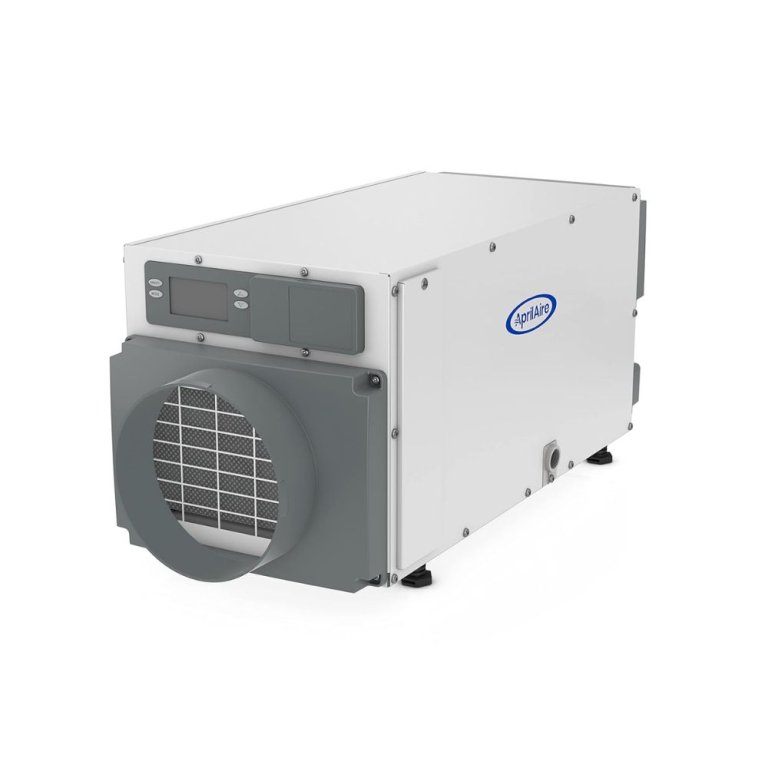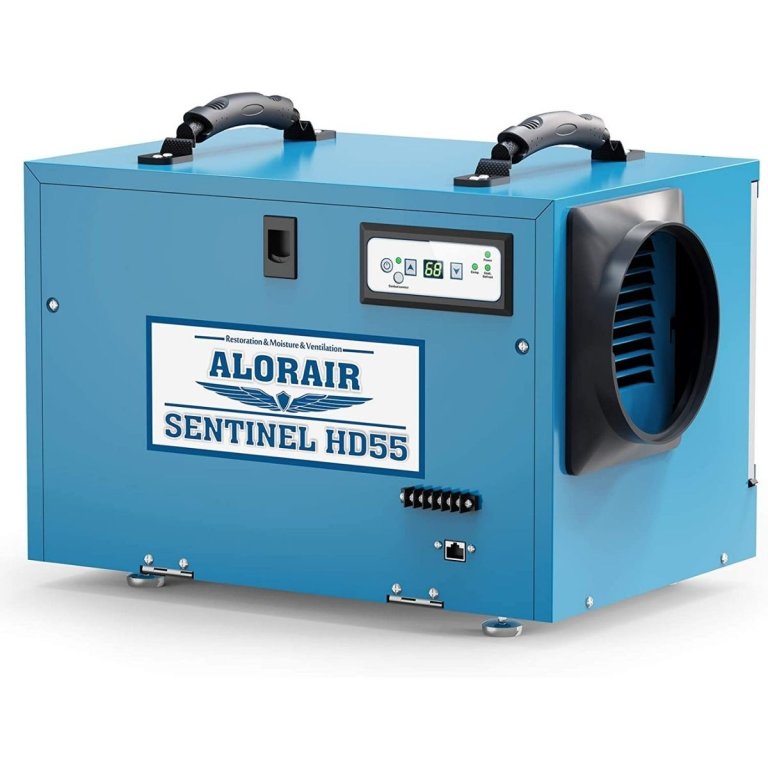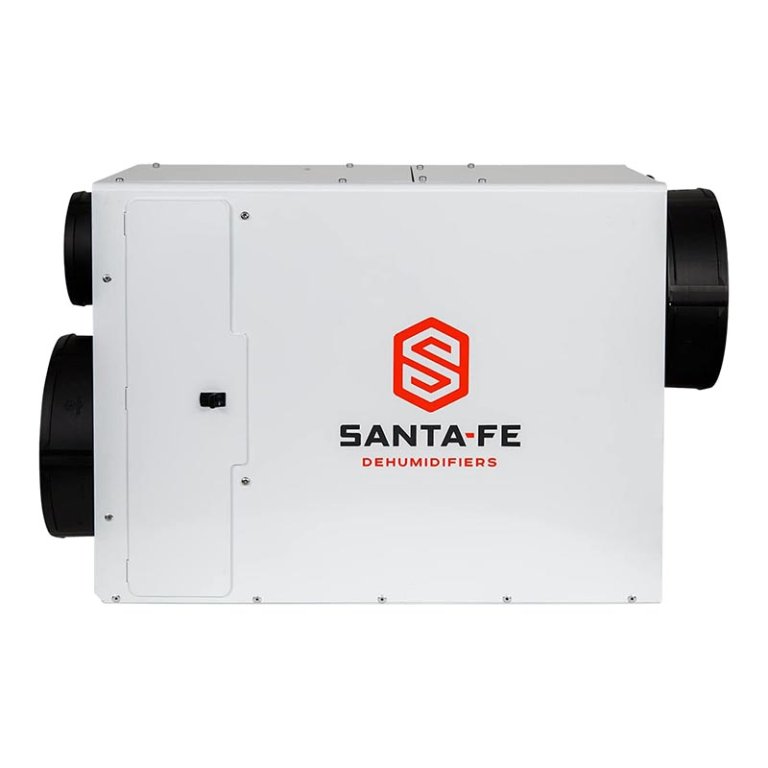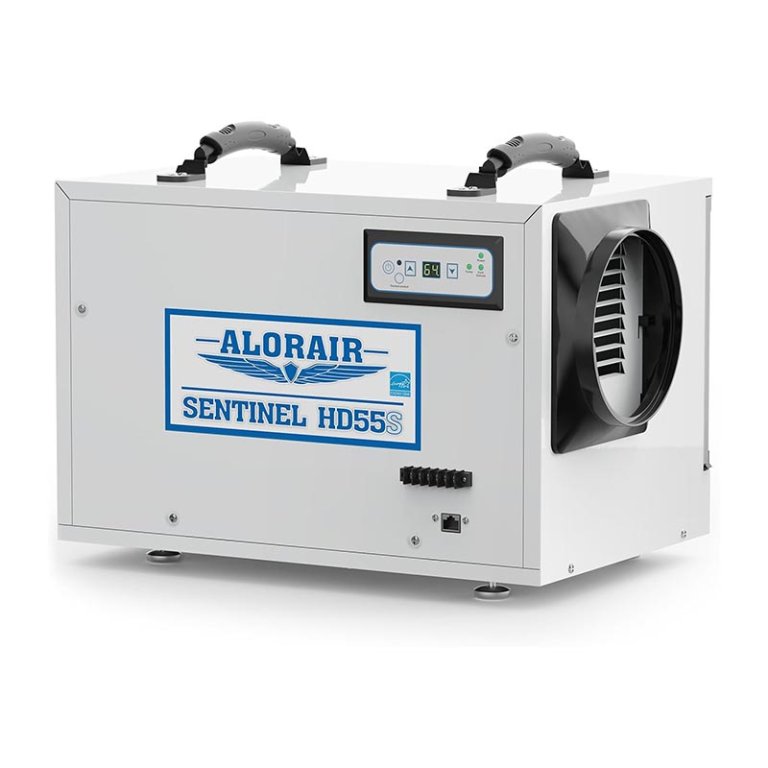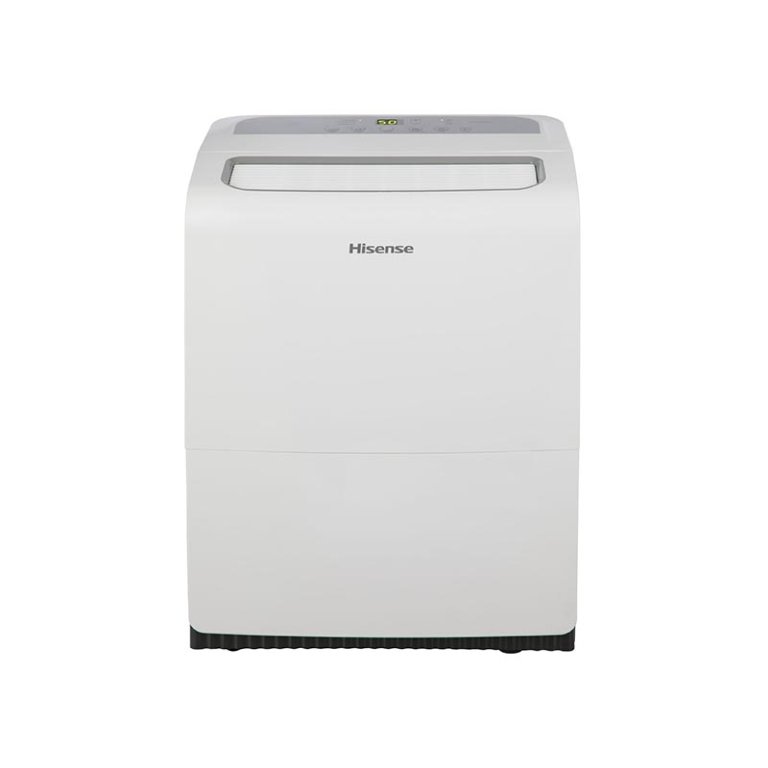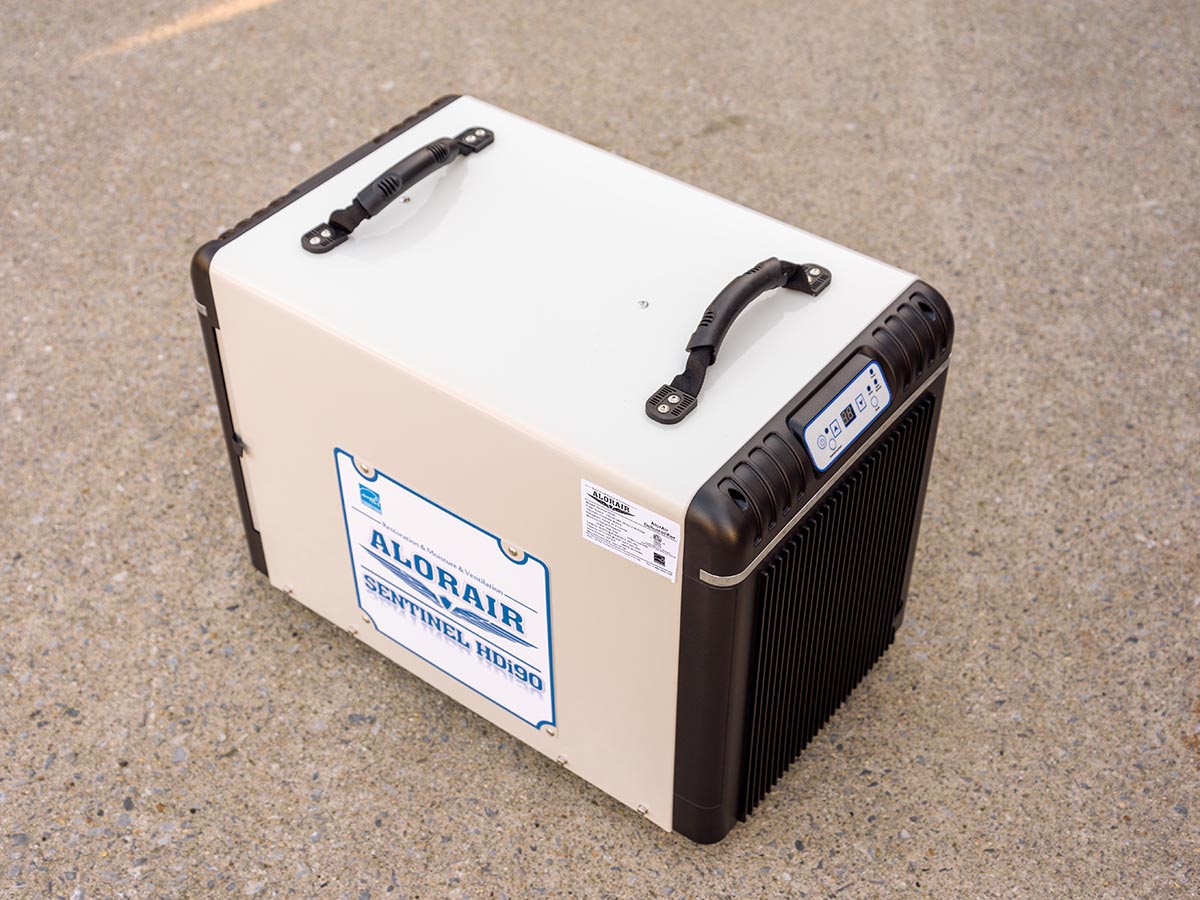
We may earn revenue from the products available on this page and participate in affiliate programs. Learn More ›
A crawl space dehumidifier can be essential for protecting your home’s structure, air quality, and overall safety. Because humidity tends to rise in these areas, they’re prone to developing mold, mildew, rot, and other moisture-related damage over time, which can adversely affect home safety. Installing a dehumidifier helps prevent such problems, as these machines pull in humid air, remove the moisture, and send fresh, dry air back out.
To help you find the right crawl space dehumidifier for your home, we tested six popular models in a sealed basement crawl space. While all options proved effective, each model has unique features that make it better suited to specific needs. Our top choice is the AprilAire E070 70-Pint Crawl Space Dehumidifier for its 2,200-square-foot coverage area, 200 cubic feet per minute (CFM) airflow, corrosion-resistant aluminum coils, and automatic operation.
Keep reading to review the best crawl space dehumidifiers of the year and learn which features matter most when choosing the right one to complement your home’s heating and cooling system.
- BEST OVERALL: AprilAire E070 70-Pint Crawl Space Dehumidifier
↓ Jump to Review - BEST BANG FOR THE BUCK: AlorAir HD55 Basement/Crawl Space Dehumidifier
↓ Jump to Review - BEST FOR HVAC: Santa Fe Ultra98 Whole-House Ventilating Dehumidifier
↓ Jump to Review - BEST FOR SMALL SPACES: AlorAir HD55S Basement/Crawl Space Dehumidifier
↓ Jump to Review - BEST FOR LARGE SPACES: Hisense 60-Pint Built-In Pump Dehumidifier
↓ Jump to Review
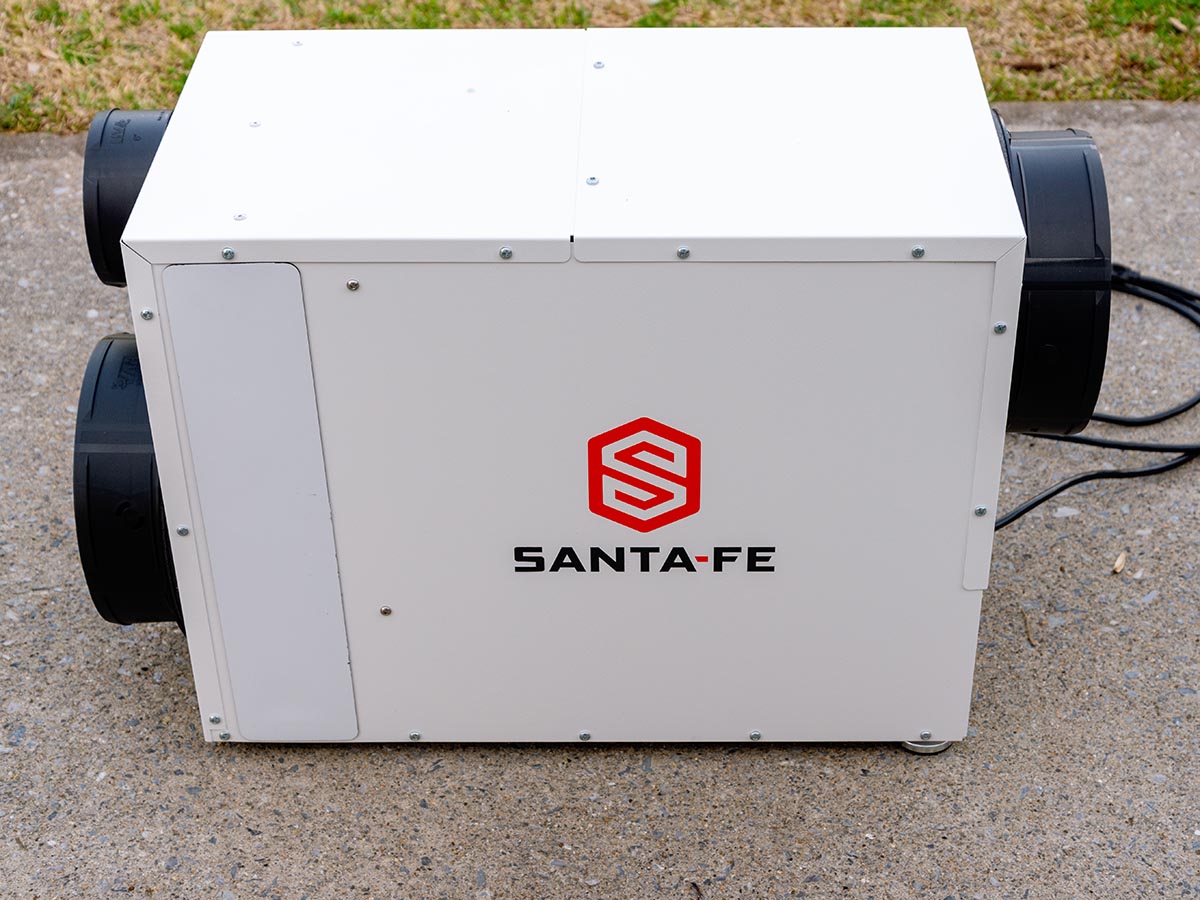
Crawl Space Dehumidifiers Comparison
| Product | Coverage Area | Airflow | Pint Capacity |
|---|---|---|---|
| AprilAire E070 70-Pint Crawl Space Dehumidifier | Up to 2,200 square feet | 200 CFM | 70 pints per day (PPD) |
| AlorAir HD55 Basement/Crawl Space Dehumidifier | Up to 1,200 square feet | 120 CFM | 53 PPD |
| Santa Fe Ultra98 Whole-House Ventilating Dehumidifier | Up to 2,300 square feet | 320 CFM | 98 PPD |
| AlorAir HD55S Basement/Crawl Space Dehumidifier | Up to 1,300 square feet | 130 CFM | 55 PPD |
| Hisense 60-Pint Built-In Pump Dehumidifier | Up to 4,500 square feet | Not listed | 70 PPD |
Our Top Picks
When it comes to choosing a dehumidifier to reduce moisture levels and musty smells in your home, be sure to review each model’s coverage area, capacity, and control options to find the right one.
Best Overall
Photo: AmazonWhat We Like
- Corrosion-resistant aluminum coils
- Sufficient airflow and water removal capacity for most crawl spaces
- Automatically starts when humidity hits a set range
- Gravity drain system never needs emptying
What We Don’t Like
- Can’t pump condensate to an elevated drain
- Larger and heavier than models with similar capacity
Specs
- Coverage area: Up to 2,200 square feet
- Airflow: 200 CFM
- Pint capacity: 70 pints per day (PPD)
Our Ratings: Ease of Use 5/5; Noise 5/5; Effectiveness 5/5; Value 4/5
With the ability to remove up to 70 pints of water from the air per day, the AprilAire E070 is an ideal choice for dehumidifying sealed crawl spaces up to 2,200 square feet. Even in loosely sealed crawl spaces up to 1,800 square feet, it’s capable of maintaining relative humidity within the ideal range of 40 to 60 percent.
Installation was smooth thanks to simple setup instructions, so we had this pick up and running within 15 minutes. We connected 10-foot lengths of flexible air duct to the intake and outflow collars to maximize efficiency, and within 12 hours, humidity had dropped from 70 percent to 58 percent. After 24 hours it was down to 49 percent, and it stayed in the mid 40s after that only cycling on intermittently.
In addition to being incredibly effective, the E070 has several user-friendly features that made it one of the easiest models to use. It has an onboard digital control near the air intake with a large display and intuitive interface. It comes with an air filter, gravity drain, and corrosion-resistant aluminum coils for years of dependable service and easy maintenance. For safety and convenience, it offers automatic defrost and retains the most recent humidity setting after a power outage. While it’s higher priced than several others we tested, it also did a better job of reducing humidity and keeping it down. Also, it’s quiet enough we couldn’t hear it running from our main floor.
What our tester says: “This was one of the easiest units to install, and the results were almost immediate. Humidity levels dropped significantly in just 12 hours and even more in 24.”—Mark Wolfe, Product Reviews tester and writer
Get the AprilAire crawl space dehumidifier at Amazon or Sylvane.
Best Bang for the Buck
Photo: amazonWhat We Like
- Built-in filter prolongs the unit’s lifespan
- Gravity-draining design makes it easy to use
- Automatic defrost setting prevents malfunction in colder climates
- Can buy a remote for use in tight spaces
What We Don’t Like
- Removes moisture slowly once level is below 55 percent
Specs
- Coverage area: Up to 1,200 square feet
- Airflow: 120 CFM
- Pint capacity: 53 PPD
Our Ratings: Ease of Use 3.8/5; Noise 4/5; Effectiveness 3.8/5; Value 4.6/5
Anyone hunting for a medium-capacity unit to fix their crawl space moisture issues will want to take a look at AlorAir’s HD55 commercial crawl space dehumidifier. This model features a 113 PPD capacity in saturation conditions and 53 PPD in Association of Home Appliance Manufacturers (AHAM) conditions, making it suitable for spaces up to 1,200 square feet (which includes most residential crawl spaces). It comes with a filter to prolong its life, which is easy to access from the side.
Besides its capacity, this gravity-draining tankless dehumidifier has plenty of desirable extras. It features an automatic defrost setting to protect the coils from freezing as well as memory restart, which allows it to pick up where it left off after a power outage. The HD55 is also compatible with a remote control for easy settings and readings, but it is a separate purchase.
We were pleased with this budget-friendly model’s price, quiet operation, and easy setup, though it was slightly less effective than our top performer as humidity approached the target range. Starting at 67 percent humidity, it reduced the reading to 59 percent in the first 12 hours. In the second 12 hours, it only came down to 53 percent. The slowdown (which we observed to some extent in all of the models tested) was due in part to lower moisture concentration and an 8-degree Fahrenheit drop in ambient temperature. In a fully encapsulated crawl space, results would likely be faster and more consistent. Although it is labeled for 1,200 square feet, we’d anticipate better results in a slightly smaller space.
Get the AlorAir HD55 crawl space dehumidifier at Amazon or AlorAir.
Best for HVAC
Photo: AmazonWhat We Like
- Dehumidifies large volume of air, even in warm climates
- Works with HVACs to maintain high-quality indoor air
- Flexible horizontal or vertical discharge
- Operates as quietly as a refrigerator (47.5 decibels)
What We Don’t Like
- Installation requires ductwork reconfiguration
- Necessary control pad isn’t included
Specs
- Coverage area: Up to 2,300 square feet
- Airflow: 320 CFM
- Pint capacity: 98 PPD
Our Ratings: Ease of Use 4/5; Noise 4.5/5; Effectiveness 5/5; Value 4/5
The Santa Fe Ultra98 offers more installation adaptability than any of the other crawl space dehumidifiers we tested. Designed to function as a whole-house dehumidifier, it provides dedicated moisture control, fresh air ventilation, and air filtration for up to 2,300 square feet. The compact, insulated cabinet keeps noise to a minimum, and you can configure the unit for either horizontal or vertical clean air discharge.
The Ultra98 performed exceptionally well in our tests, efficiently reducing humidity while noticeably improving air quality. We also liked that it has a secondary adjustable fresh air intake that infused filtered, oxygen-rich outdoor air into our home. The build quality was extremely sturdy, and the unit operated at a very low noise level.
Installation, however, was complex. For top efficiency, the air intake needs to be ducted to a dedicated indoor air return and the supply fitted to the main HVAC supply duct (though less-efficient configurations are also an option). Since the process took us most of the day as advanced DIYers, those with less experience will want to hire an HVAC professional. Also, this pick doesn’t come with the required control pad, which adds to the overall expense. Still, for those seeking to efficiently treat a large volume of air and help their home’s HVAC perform better, the Ultra98 will be hard to beat.
Get the Santa Fe crawl space dehumidifier at Amazon or Sylvane.
Best for Small Spaces
Photo: AmazonWhat We Like
- Energy Star certified
- Requires little maintenance and has an automatic defrost function
- Removable filter and gravity drain included
- Features automatic restart in case of a power outage
What We Don’t Like
- Tricky manual adjustment; remote control sold separately
- Necessary control pad isn’t included
Specs
- Coverage area: Up to 1,300 square feet
- Airflow: 130 CFM
- Pint capacity: 55 PPD
Our Ratings: Ease of Use 3.8/5; Noise 4/5; Effectiveness 3.8/5; Value 5/5
For smaller crawl spaces, large units are a waste of money and energy consumption. In these cases, a compact model like this AlorAir HD55S is a smart choice. Designed for areas up to 1,300 square feet, it removes up to 55 pints of moisture per day under AHAM conditions (and up to 120 PPD at saturation). It’s also Energy Star certified, making it more cost-effective to run over time.
While this unit is small in size, it’s not short on features. It has an automatic defrost mode to prevent coil freeze in cold weather and a removable filter to help keep the system clean. The unit supports gravity drainage and is remote-control compatible, though the remote is sold separately. Also, should the power go out, it remembers its settings and continues to dehumidify once power is restored.
In testing, the AlorAir HD55S did a great job under high humidity conditions. It lowered the humidity in our crawl space from 66 percent to 55 percent in just under 18 hours. However, the drying rate slowed in the last stretch, with a final reading of 52 percent at 24 hours. In an encapsulated environment, we’d expect faster and more consistent results from this Energy Star–certified dehumidifier.
Get the AlorAir HD55S crawl space dehumidifier at Amazon or AlorAir.
Best for Large Spaces
Hisense 60-Pint Built-In Pump Dehumidifier
Buy It at Lowe'sWhat We Like
- High dehumidification capacity
- Continuous drain option
- Easy, intuitive control panel
- Low operating noise
What We Don’t Like
- More expensive than similar options
Specs
- Coverage area: Up to 4,500 square feet
- Airflow: Not listed
- Pint capacity: 60 PPD
Our Ratings: Ease of Use 4.7/5; Noise 5/5; Effectiveness 5/5; Value 4.3/5
The Hisense 60-pint dehumidifier is a powerful portable unit built to handle large areas up to 4,500 square feet. With a high-capacity design and strong 3-speed fan, this crawl space dehumidifier with pump moves air efficiently to reduce moisture levels rapidly. It comes with a quick-connect hose for continuous drainage (even to an elevated drain), which is helpful in sloped or partially finished crawl spaces.
During testing, we found this Hisense dehumidifier both well designed and easy to operate. It has user-friendly touch controls, clear LED indicator lights, and a quiet motor that keeps noise to a minimum. It also comes with a reusable, washable air filter that helps capture dust and larger particulates to maintain better air quality in enclosed crawl spaces. As a portable unit, you can also use this pick in other areas of the house, and it has an automatic shutoff to prevent overflow if the bucket fills, plus a full-tank indicator to alert you when maintenance is needed. As a relatively large unit that weighs 57 pounds, however, moving this portable unit up and down stairs and into tight access points requires a bit of effort. Once it’s in place, you’ll likely want to leave it there.
What our tester says: “The Hisense pulled moisture quickly and ran quietly, especially for a portable dehumidifier. It even outperformed some dedicated crawl space models.”—Mark Wolfe, Product Reviews tester and writer
Get the Hisense crawl space dehumidifier at Lowe’s.
Jump to Our Top Picks
How We Tested the Best Crawl Space Dehumidifiers
| Testing Stats | |
| Products tested | 6 |
| Time spent testing | 2 weeks |
| Tests performed | 5 |
| Price range | $400 to $2,400 |
For best results (and to reduce energy costs), it’s important to prepare a crawl space before installing a dehumidifier. At a minimum, you’ll want to install or replace a vapor barrier, a heavy-duty plastic liner that covers the space’s dirt floor. If you live in a region with high humidity year-round, fully encapsulating the crawl space is an even better option.
Since our vapor barrier is only 2 years old and in good condition, we moved on to the next steps. We created a level platform, ran an extension cord to power the test units, and extended a flexible drain hose from the platform to the sump pump. One by one, we installed each crawl space dehumidifier for a 5-day period, targeting a humidity level of 50 percent. We recorded temperature and humidity readings at 6-hour intervals during the first day of the test and daily thereafter. We also noted the noise level inside the home during operation, scored each unit based on our results, and assigned worthy models relevant awards.
| Product | Ease of Use | Noise | Effectiveness | Value |
| AprilAire E070 70-Pint Crawl Space Dehumidifier | 5 | 5 | 5 | 4 |
| AlorAir HD55 Basement/Crawl Space Dehumidifier | 3.8 | 4 | 3.8 | 4.6 |
| Santa Fe Ultra98 Whole-House Ventilating Dehumidifier | 4 | 4.5 | 5 | 4 |
| AlorAir HD55S Basement/Crawl Space Dehumidifier | 3.8 | 4 | 3.8 | 5 |
| Hisense 60-Pint Built-In Pump Dehumidifier | 4.7 | 5 | 5 | 4.3 |
What to Consider When Choosing a Crawl Space Dehumidifier
No one wants mold or mildew growing under their feet, and the best crawl space dehumidifier will help ensure neither can thrive. While these dehumidifiers work very similarly to indoor and basement dehumidifiers, there are some differences and points to keep in mind when shopping for one.
Coverage Area
Choosing a properly sized dehumidifier is critical to ensure it’s able to handle the task at hand. If it’s too small, it won’t be able to remove humidity from an entire crawl space. If it’s too large, it’ll use more electricity than necessary and cost too much upfront.
- Square footage: Most dehumidifiers for crawl spaces clearly describe the amount of space they’re able to cover. Smaller models can handle a few hundred square feet whereas humidifiers for large rooms can accommodate several thousand.
- PPD AHAM: Along with square footage, shoppers will notice a PPD AHAM value, which describes how many pints of water the dehumidifier can remove per day in a specific condition. AHAM sets these conditions at 80 degrees Fahrenheit and 60 percent relative humidity.
- Saturation: Many dehumidifier manufacturers also describe how many pints their units can remove in saturated conditions. This value is often quite a bit higher and lacks the same level of standardized testing as PPD AHAM.
Humidistat
Humidistats are an important feature to look for in tools promising dehumidification of a crawl space. They allow the user to set a desired humidity level that automatically turns the unit on when readings exceed it and off again when they drop below it.
- Since even the best crawl space dehumidifier uses quite a bit of electricity, running it constantly is great for power companies but not bank accounts. Humidistats throttle these machines’ electrical output so they only run when they need to.
- Crawl spaces are dark, dirty, and very tight, meaning they aren’t particularly people-friendly places. A humidistat prevents you from having to head in to check humidity levels and manually activate your dehumidifier.
Defrosting System
Crawl spaces are popular in many areas across the country, and many of those areas get very cold in the winter. Leaving a crawl space dehumidifier exposed to the elements can freeze the condensation coils and destroy the machine. For this reason, a defrosting system is essential.
The defrosting system maintains a warmer temperature within the dehumidifier. This prevents cold air from freezing the condensed water or coils, allowing the unit to run much longer. Even in areas where temperatures aren’t likely to freeze, it can be an important feature. In fact, it only takes one time for a freeze to break a coil.
Condensate Pumps
Like household dehumidifiers, crawl space units remove moisture from the air and collect it as water. But unlike household models, it’s neither practical nor realistic to crawl under the house twice a day to empty a tank. That’s why most crawl space dehumidifiers rely on drainage systems. In some cases, a condensate pump is also required for effective operation.
Units equipped with condensate pumps can move water where it needs to go, even through long hose runs or to drains located above the unit. The pump automatically pushes the collected water out of the crawl space, eliminating the need for manual emptying.
Noise Level
The average home dehumidifier generates a noise similar to the hum of a window air conditioner, and the larger the capacity, the louder the device will be. Most small dehumidifiers produce between 30 decibels (comparable to a normal conversation) and 45 decibels (comparable to the hum of a refrigerator), but manufacturers aren’t required to list the noise levels on their units.
Reading customer reviews is the best way to determine how noisy a specific dehumidifier will be. If you want to lessen the noise of your unit, placing it on a level and padded surface can help.
Cost and Energy Efficiency
Dehumidifiers can provide a continuous flow of fresh, dry air in your crawl space, resulting in an energy-efficient solution that can improve air quality and keep mold growth at bay all season long. Small dehumidifiers suitable for crawl spaces will likely run on 280 to 300 watts of power, meaning that they will consume 4 to 5 cents of power per hour. This equates to roughly $150 per year if your dehumidifier is on for 9 to 10 hours a day.
However, Energy Star–certified dehumidifiers use about 15 percent less energy than conventional units. In the long run, that means a savings of approximately $175 over the life of a dehumidifier, not to mention avoiding ample greenhouse gas emissions.
Additional Features
A few other features might make a particular model the best crawl space dehumidifier for your needs.
- Filtration: A combo basement dehumidifier and air purifier (which many crawl space units are) will have an air filter to collect dust and other particles, allowing the unit to last longer and the space underneath the home to stay fresher.
- Digital controls: These allow you to select the desired humidity level by percentages, such as 35 percent or 45 percent humidity. The unit will shut off automatically when the moisture in the room meets the preset level and turn back on when necessary.
- Memory or auto restart: Many of the most humid months bring thunderstorms with them, which often knock out the power. Some models with auto-restart or memory functions will remember their settings prior to the power outage and continue working where they left off.
- Timers: Timers let you program the dehumidifier to turn on and off automatically at a preset time so you don’t have to do it manually.
- Easy-carry collection tanks: Though not as common on crawl space units unless they’re portable, collection tanks should have well-designed spouts with comfortable handles so you can dump water without spilling.
- Frost sensors: These sensors detect frost buildup and turn the machine off to save energy. When a compressor unit runs for long periods of time, frost can develop on the coils, which reduces the dehumidifier’s effectiveness. While a unit with frost buildup will continue to run, it won’t remove moisture from the air as effectively. Some models also come with a restart feature that turns the unit back on after the coils have defrosted.
- Water level sensors: These sensors are common on portable units and alert you when your tank’s water level is approaching or has reached max capacity. Though most produce an auditory alarm, some models will also alert you via smartphone.
- Wheels: Also more common on portable units than dedicated crawl space machines, wheels make it easy to move heavy dehumidifiers from room to room.
Installation
Before selecting a dehumidifier, it is important to measure your space to know which model will perform best. During installation, place the unit where airflow won’t be obstructed, noise won’t be disruptive, and drainage (if required)is easy to access.
While many models are simple to set up on your own, those that connect to an HVAC system may require a contractor. If you’re tackling a DIY installation, you may need tools like a drill or screwdriver, hammer and nails, metal straps, PVC pipes, or rubber tubing, depending on the model you choose.
FAQs
Even with the above info on choosing the best dehumidifier for insulated crawl spaces, you might still have a few remaining questions. Below are answers to some of the most common questions about crawl space dehumidifiers.
Technically, you could, but they really aren’t meant to be crawl space solutions. Regular dehumidifiers’ coils aren’t durable, they rarely feature defrost functions, and most have tanks that require emptying. Also, crawl space dust is sure to limit an indoor unit’s lifespan.
As crawl spaces are likely to be very damp, a dehumidifier with a 50-pint tank or more is recommended to allow for ample drying.
You set a crawl space dehumidifier to a relative home humidity level, not a temperature. As a general rule, keep that space within the ideal range of 40 to 55 percent humidity, so setting the unit to 50 percent should do the trick.
You’ll want to set up the dehumidifier in an area where it can draw in moist air and push out dry air without obstruction. It’s best to set it up in the center of the crawl space.
The best dehumidifiers will reduce the humidity in a crawl space in 8 to 12 hours, depending on the size of the space and its current moisture levels.
Dehumidifier maintenance and cleaning are relatively straightforward, as most parts just need to be wiped down with a damp cloth. If the reservoir has any limescale buildup, you should be able to remove it with white vinegar or lemon juice. A dehumidifier for crawl space filter usually needs a quick rinse once a month.
If maintained properly, you can expect a crawl space or under-house dehumidifier to last around 5 years. To ensure the longevity of your machine, be sure to follow the manufacturer’s instructions for setup, use, and maintenance.
Meet the Tester
Mark Wolfe is a writer with an extensive background in the green industry and an avid DIYer who lives in a 50-year-old home. When he isn’t writing, he spends his time upgrading, repairing, and replacing anything and everything in his home, yard, and garden. He tests and writes reviews about hand tools, lawn care and home repair products, and outdoor living goods.
Additional research provided by Tom Scalisi.



